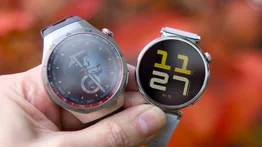Microsoft Band review

Microsoft's first wearable packs in plenty of features and is OS-agnostic, but it's hardly sleek or comfortable to wear
Specifications
Pedometer: Yes, Heart-rate monitor: Yes, Display size: 1.4in, Resolution: 320×106, OS support: iOS 7.1+, Android 4.3+, Windows Phone 8.1+, Battery life: 48 hours
BATTERY LIFE
Unsurprisingly given its size, the Band only has room inside for a 100mAh battery. Microsoft says the Band should last around 48 hours on a single charge, as long as you don’t use battery-intensive features like GPS. This was largely true in our testing, although using GPS on our 45 minute cycle commute to and from work meant we needed to put the Band on charge after only 30 hours of use. Frustratingly, if the battery dies completely before you sync the Band to your smartphone, all recorded activities are lost.
Band uses a proprietary magnetic charging adapter, which plugs into any USB port or USB power adapter. It takes less than an hour to fully charge the device, but if you forget to bring the cable with you when leaving the house there’s no way to charge it up without it.

COMPANION APP
Microsoft Health, the companion app that takes readings from all of Band’s sensors, is the heart of Band’s ecosystem. It’s available on all three smartphone operating systems, and is used to pair the two devices together using Bluetooth LE. It creates a user profile and tracks your activity history, letting you check metrics like pace, distance, GPS routes and calories burned, but in terms of using that data effectively there’s little you can do with it.
Bizarrely at launch there was no way to check some of Band’s more unique sensor readings. We couldn’t find skin temperature readings anywhere, and the galvanic skin response sensor that supposedly measures sweat and stress also appears to operate in the background, rather than produce data the user can actually access. Out of the box it supported more familiar fitness tracking apps like MapMyFitness, MyFitnessPal and RunKeeper to put your split times to better use, but the app was undeniably bare-bones. Microsoft promised more was to follow in the future, and sure enough an update released in mid-April added support for Strava and MapMyRide, which should be welcome news for cyclists. New insights let you compare your health statistics with people of similar height and weight (anonymously) to give you a better idea of your general level of fitness. However, we’re still waiting for an update that better displays Band’s more advanced measurements.
Band might play nicely with both Android and iOS, making it one of the first truly universal wearables available to smartphone owners, but you’ll be missing out on certain features unless you have a Windows Phone handset. Thankfully a Windows program called unBand gives you the greater customisation options available in Windows Phone regardless of your smartphone, and even lets you export your exercise data for use in other applications and services. There’s no way to add your data into Apple’s Health app, however.
CONCLUSION
The Microsoft Band has a lot of positive features. It’s packed with sensors, works well with every smartphone OS, from a fitness point of view, and measures genuinely useful metrics. However, it’s largely uncomfortable to wear given its bulk and rigid design, unless your wrist happens to fit one of the three band sizes perfectly, and for a device designed to get you active it’s a shame there’s no official way to export your data into other services.
There’s not really any alternative that’s quite as well rounded as Band, but it has a long way to go until we’d be ready to recommend you buy one.
| Hardware | |
|---|---|
| Pedometer | Yes |
| Heart-rate monitor | Yes |
| GPS | Yes |
| Waterproof | yes (splashproof) |
| Other features | |
| Display | |
| Display size | 1.4in |
| Resolution | 320×106 |
| Display technology | LCD |
| Smartphone connection | |
| OS support | iOS 7.1+, Android 4.3+, Windows Phone 8.1+ |
| Wireless | Bluetooth 4.0 LE |
| Battery | |
| Battery size | 100mAH |
| Battery life | 48 hours |








